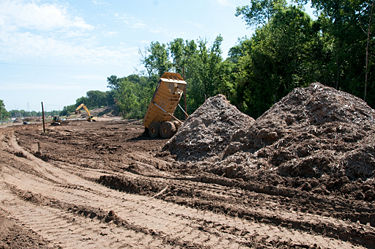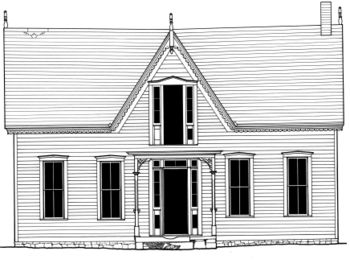Category:201 Clearing and Grubbing: Difference between revisions
m updated links |
mNo edit summary |
||
| Line 47: | Line 47: | ||
:201.2.5.4 Disposal of Timber. As specified. | :201.2.5.4 Disposal of Timber. As specified. | ||
===201.3 Method of Measurement=== | |||
Quantities are established by contract. No measurement for final payment is required except as per [http://www.modot.org/business/standards_and_specs/SpecbookEPG.pdf#page=5 Sec 201.3]. A unit bid price is established by contract in the event additional payment for clearing and grubbing is justified. | |||
A contractor notice of error with measurements documenting the error is required prior to clearing the disputed area. The resident engineer will accept or reject the claim by the end of the next business day. | A contractor notice of error with measurements documenting the error is required prior to clearing the disputed area. The resident engineer will accept or reject the claim by the end of the next business day. | ||
===201.4 Basis of Payment=== | |||
As specified. | |||
Revision as of 08:24, 13 May 2021

Clearing and grubbing is estimated during the design field check and, in conjunction with aerial photographs if available, consistent with the method of measurement given in the standard specifications. The standard specifications establish the size of trees and stumps that qualify for payment as clearing and grubbing.
Roadways designed with clear zones are cleared at least to the minimum clear zone width. Use other roadway exceptions to decrease the cost of roadside maintenance and to improve the appearance of the completed facility. Clearing is excepted at the top of deep cuts, the bottom of high fills, in areas not conveniently accessible to maintenance equipment, in areas where the natural growth of trees and shrubbery will blend with adjacent areas and at all other locations where natural trees and shrubbery will improve the appearance without detracting from the service of the completed facility. Clearing exceptions can be used to control erosion at interception and roadway ditch outlets. Areas that are not to be cleared are outlined on the plans and noted as "No Clearing" or "N. C." in accordance with Sample Plans. This area should provide sufficient clearance for equipment to construct items such as interception ditches and levees at the top of backslopes or at the bottom of fillslopes. When the entire surface of the right of way is not to be cleared, the following general note is included on the first plan-profile sheet:
- "Areas noted 'No Clearing' or 'N. C.' on the plans are not to be cleared of trees, undergrowth, brush, grass, weeds or natural rock formations."
The clearing and grubbing quantity is estimated and pay items in acres [hectares] are included. The quantity of acres [hectares] is to be placed on the Summary of Quantities 2B sheet.
Construction Inspection Guidelines for Sec 201
201.1 Description
Clearing and grubbing is the first order of work on most projects. Clearing and grubbing includes removal of all trees, stumps, roots and any objectionable matter resting on or protruding through the surface of the original ground, except for those items designated to remain.
For Sec 201.2 Construction Requirements

201.2.1 General. The contractor is responsible to protect and preserve all property affected by the contractor's work. The contract will provide detailed instructions for clearing the work site. Trees, shrubs, survey or historical markers, objects of historical or archaeological value, utilities, etc. that are shown on the plans to be preserved or to remain in place are the contractor's responsibility. If there are such items that have not been noted on the plans or in the proposal, but are desirable to preserve, they must be clearly marked and brought to the contractor's attention in writing, after which the contractor becomes responsible for their preservation. The resident engineer or the inspector should not direct how protection is to be accomplished unless the method is specified in the contract. Necessary protection shall be continued for the life of the contract. If the contractor's activities damage the items to be preserved, the contractor shall pay for and is responsibility to repair or make good such damaged items.
201.2.2 Clearing and Grubbing. Unless otherwise specified in the contract documents, the entire length of the project shall be cleared and grubbed to the limits and requirements specified.
- 201.2.2.1 Clearing. As specified.
- 201.2.2.2 Limits of Grubbing. As specified.
- 201.2.2.3 Selective Clearing and Grubbing. As specified.
201.2.3 Scalping
As specified.
201.2.4 National Forest Land
When a project is located in a National Forest area, the resident engineer should check with the Ranger in charge to determine that the contractor has, before starting work, complied with requirements of the specification regarding construction procedures in National Forests. The Mark Twain National Forest Headquarters is in Rolla, Missouri. Telephone Number (573) 364- 4621.
- 201.2.4.1 Before any clearing or grubbing is performed, the resident engineer should check plans for areas that require selective clearing and for government markers that may be located on the right of way. All areas or fixtures that are not to be disturbed should be plainly marked in a manner that all concerned will understand to mean Do Not Disturb. Removing vegetation (scalping) outside construction limits is not permitted. Areas of right of way outside excavation and embankment limits marred or defaced by the contractor’s equipment or methods must be restored to satisfactory condition at his expense.
- 201.2.4.2 Products of clearing and grubbing on other than National Forest areas are considered the property of the contractor. Disposal in accordance with the specifications is his responsibility. In National Forest areas the resident engineer must see that the contractor complies with rules, regulations, and construction procedures specified by the Ranger in charge of the area for disposition of the products of clearing and grubbing.
- 201.2.4.3 On forest highway projects, the resident engineer should contact the Ranger in charge for the Forest Service about 30 days before final inspection of the project is anticipated and arrange for a joint inspection as to cleanup of right of way. This should eliminate any delay in making final acceptance of such projects.
201.2.5 Removal and Disposal of Material
Refer to EPG 202.5.3.2 Disposal of Material (for Sec 202.2.1).
- 201.2.5.1 Open Burning. As specified.
- 201.2.5.2 Disposal of Wood. As specified.
- 201.2.5.3 Disposal of Scalping. As specified.
- 201.2.5.4 Disposal of Timber. As specified.
201.3 Method of Measurement
Quantities are established by contract. No measurement for final payment is required except as per Sec 201.3. A unit bid price is established by contract in the event additional payment for clearing and grubbing is justified.
A contractor notice of error with measurements documenting the error is required prior to clearing the disputed area. The resident engineer will accept or reject the claim by the end of the next business day.
201.4 Basis of Payment
As specified.